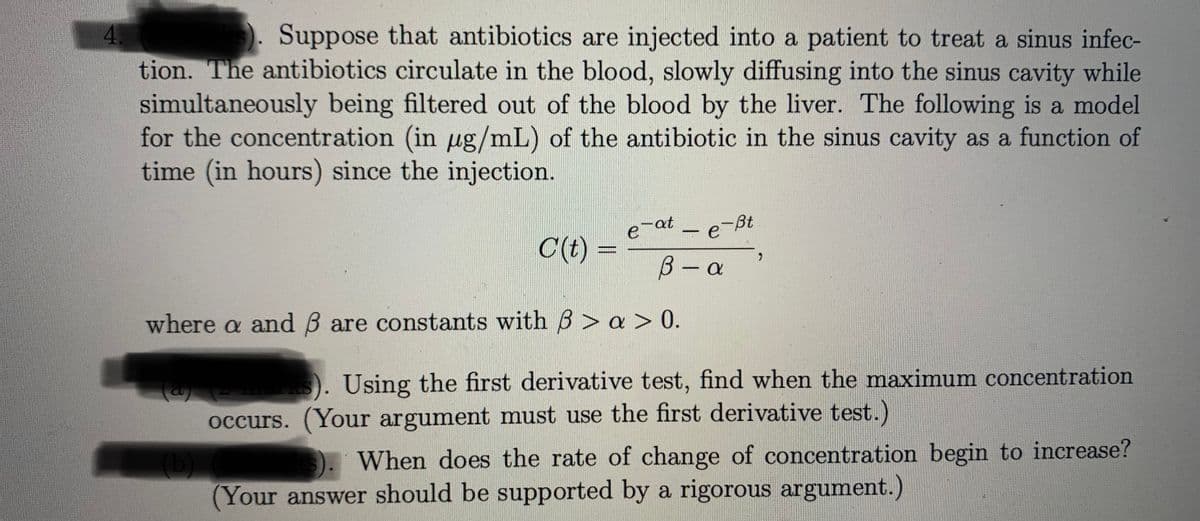Suppose that antibiotics are injected into a patient to treat a sinus infec- tion. The antibiotics circulate in the blood, slowly diffusing into the sinus cavity while simultaneously being filtered out of the blood by the liver. The following is a model for the concentration (in ug/mL) of the antibiotic in the sinus cavity as a function of time (in hours) since the injection. e-at - e-Bt C(t) = B- a where a and B are constants with B> a > 0. Using the first derivative test, find when the maximum concentration occurs. (Your argument must use the first derivative test.) When does the rate of change of concentration begin to increase? (Your answer should be supported by a rigorous argument.)
Suppose that antibiotics are injected into a patient to treat a sinus infec- tion. The antibiotics circulate in the blood, slowly diffusing into the sinus cavity while simultaneously being filtered out of the blood by the liver. The following is a model for the concentration (in ug/mL) of the antibiotic in the sinus cavity as a function of time (in hours) since the injection. e-at - e-Bt C(t) = B- a where a and B are constants with B> a > 0. Using the first derivative test, find when the maximum concentration occurs. (Your argument must use the first derivative test.) When does the rate of change of concentration begin to increase? (Your answer should be supported by a rigorous argument.)
Linear Algebra: A Modern Introduction
4th Edition
ISBN:9781285463247
Author:David Poole
Publisher:David Poole
Chapter6: Vector Spaces
Section6.7: Applications
Problem 16EQ
Related questions
Question

Transcribed Image Text:4.
). Suppose that antibiotics are injected into a patient to treat a sinus infec-
tion. The antibiotics circulate in the blood, slowly diffusing into the sinus cavity while
simultaneously being filtered out of the blood by the liver. The following is a model
for the concentration (in ug/mL) of the antibiotic in the sinus cavity as a function of
time (in hours) since the injection.
-at
e
e-Bt
C(t) =
B-a
where a andB are constants with B > a > 0.
). Using the first derivative test, find when the maximum concentration
occurs. (Your argument must use the first derivative test.)
When does the rate of change of concentration begin to increase?
(Your answer should be supported by a rigorous argument.)
Expert Solution
This question has been solved!
Explore an expertly crafted, step-by-step solution for a thorough understanding of key concepts.
This is a popular solution!
Trending now
This is a popular solution!
Step by step
Solved in 2 steps with 2 images

Recommended textbooks for you

Linear Algebra: A Modern Introduction
Algebra
ISBN:
9781285463247
Author:
David Poole
Publisher:
Cengage Learning


Algebra & Trigonometry with Analytic Geometry
Algebra
ISBN:
9781133382119
Author:
Swokowski
Publisher:
Cengage

Linear Algebra: A Modern Introduction
Algebra
ISBN:
9781285463247
Author:
David Poole
Publisher:
Cengage Learning


Algebra & Trigonometry with Analytic Geometry
Algebra
ISBN:
9781133382119
Author:
Swokowski
Publisher:
Cengage